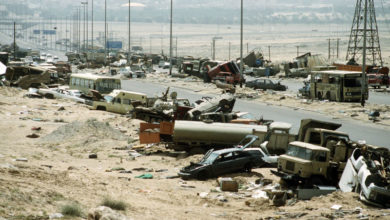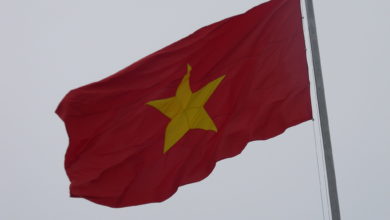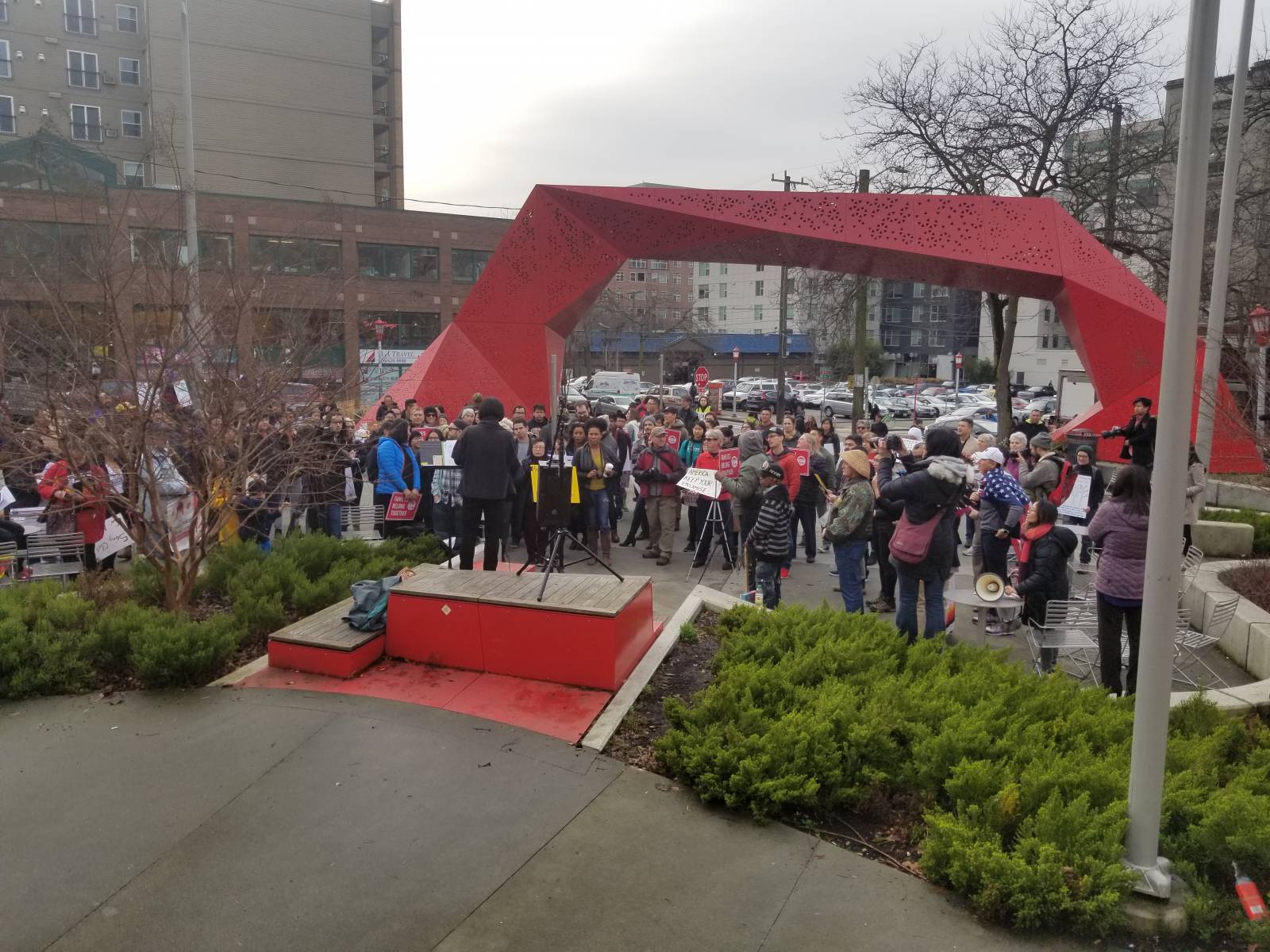 Nixon’s “secret plan” to end the war expanded U.S. aggression to Laos and Cambodia. Photo: AFP Photo/National Archives |
Two months later, in a dramatic admission that his war policy had failed, Johnson announced that he would not stand for re-election. By that point, there were more than 500,000 U.S. troops in Vietnam. The bombing of the country—north and south—had continued non-stop for over three years.
While 1968 was a turning point, it was not immediately decisive. Instead, the war entered a stage with unprecedented problems for the liberation forces. The war raged on for another seven years.
It was testimony to the superb leadership, organization and determination of the Vietnam Workers Party and the formations it led that, in the face of what appeared to be insuperable odds, the Vietnamese Revolution ultimately triumphed.
At every point in the long struggle, the liberation forces were at a severe military disadvantage. Their success, therefore, can only be understood as the victory of popular mobilization—people’s power—over a technologically superior enemy.
It would be absurd, however, to contend that the military side of the struggle was unimportant. The Vietnamese received crucial aid from the Soviet Union, China and other countries in the socialist camp. They displayed amazing resourcefulness in their military organization, production and strategy. Still, neither the weaponry nor the numbers of the liberation armed forces ever remotely approached those of the United States and the puppet “Republic of Vietnam.”
Only politics and organization could overcome the military disadvantage. How the Vietnamese achieved such a victory is not just a point of historical interest but also relates to the struggles taking place in the world today.
Nixon’s ‘secret plan’ to end the war
In the 1968 U.S. presidential election, Richard Nixon narrowly defeated Johnson’s pro-war vice president, Hubert Humphrey. Nixon ran on a platform that promised a “secret plan” to end the war. In reality, Nixon was as determined to win the war as Johnson had been. But after the Tet Offensive and other setbacks, the U.S. military realized it couldn’t just proceed as before.
Nixon and his national security advisor, Henry Kissinger, hatched a new strategy, which widened the war instead of ending it. It consisted of three basic elements.
First, it called for the “Vietnamization” of the war. In order to reduce U.S. casualties, Nixon planned to gradually withdraw U.S. ground combat forces and replace them with a massively built-up Army of the Republic of Vietnam (ARVN). U.S. officers would continue to play a key role in military strategy. More importantly, the U.S. Air Force would play an expanded role. Along with the “Vietnamization” plan, the Pentagon intensified the Phoenix Program, a protracted CIA death squad assassination campaign aimed at killing as many NLF civilian cadres as possible.
Second, the United States widened the air war to target Laos and Cambodia. This plan, carried out largely in secret, aimed to destroy the liberation forces’ command and rear bases in the border areas of those neighboring countries.
Third, Nixon and Kissinger began to maneuver diplomatically with the People’s Republic of China and the Soviet Union. They hoped to further divide the two largest powers in the socialist camp and pressure them to discontinue their support for the Vietnamese struggle.
Kissinger: ‘A savage, decisive blow’
In August 1969, Kissinger told the staff of the National Security Council: “You are to start without any preconceptions at all. … It shall be the assignment of this group to examine the option of a savage, decisive blow against North Vietnam.” When asked if the planned “blow” could include nuclear weapons, Kissinger answered: “You are not to exclude the possibility of a nuclear device being used for purposes of a blockade in the pass to China [the key supply route—Ed.]”
“I refuse to believe,” said Kissinger, “that a little fourth-rate power like North Vietnam does not have a breaking point.” The code name for the NSC plans was “Duck Hook”. It included various genocidal tactics such as bombing the north’s dike system and carpet bombing the major cities of Hanoi and Haiphong. (Marilyn Young, The Vietnam Wars, 1945-90, New York, Harper,1991, p. 239)
Just weeks later, on Sept. 2, 1969, Vietnamese independence leader Ho Chi Minh died. It was the 24th anniversary of the day that he had read out Vietnam’s independence declaration in Hanoi.
His testament, written a few months earlier, expressed confidence that victory was certain. “We, a small nation, will have earned the unique honor of defeating, through a heroic struggle, two big imperialisms—France and the United States—and making a worthy contribution to the national liberation movement.”
In the end, it was Ho Chi Minh, not Kissinger, Nixon or the other U.S. war makers, that would be proven correct.
‘Vietnamization’
The greatest number of U.S. troops in Vietnam was 535,000 in 1968. In June 1969, Nixon announced the first troop reduction. By the end of the year, 475,000 U.S. forces still remained in the country. A new phase of the war was underway.
A crisis had been rapidly unfolding inside the U.S. military. With mounting casualties, unable to crush the liberation forces after three years of intensive bombing, resistance began to grow inside the U.S. military.
A key element of the Nixon-Kissinger “Vietnamization” plan was the immense build-up of the ARVN to take the place of the withdrawl of U.S. troops.
By the time it peaked in 1973, the ARVN had 1.1 million men, representing more than half of all south Vietnamese males between the ages of 18 and 35. It had the fourth largest air force in the world, with more than 740 warplanes and nearly as many combat helicopters. In addition, the ARVN received at least 1,000 howitzers, 300 tanks, 1,650 heavy mortars and more than 1,000 M-113 personnel carriers. In every category of military technology, the ARVN was vastly superior to north Vietnam’s People’s Liberation Armed Forces and People’s Army of Vietnam. (Gabriel Kolko, Anatomy of a War, New York, Pantheon, 1985, p. 378)
Yet, as the historian Gabriel Kolko has shown, the ARVN actually deteriorated as a fighting force as it grew in size. It was trained to fight the war in the same way the U.S. forces did, using massive and indiscriminate firepower. They behaved in an exploitative and abusive way toward the population, a majority of whom were with or sympathetic to the NLF.
In contrast to the liberation forces, the ARVN soldiers regularly stole, raped and brutalized. Torture and murder of suspected NLF sympathizers, by both U.S. and ARVN forces, were routine.
The ARVN was a puppet army in every sense of the word, entirely dependent on the United States for weaponry, training and funds. At the same time, it represented the backbone of the government of Nguyen Van Theiu, the U.S.-backed president of the “Republic of Vietnam.” The loyalty of the officer corps was bought by allowing the generals, colonels and other officers to engage in widespread and endemic corruption.
Corruption permeated the ARVN at every level. For example, each unit received funds based on the number of soldiers in the unit. But the rank and file soldiers, nearly all of them forced conscripts, rarely received even their full food rations, since part was routinely stolen by the officers above them. The rank and file soldiers, whose families were dependent on them for survival, had two choices: they could desert or they could exploit the population. Both happened on a mass scale.
When they deserted, their immediate superiors rarely reported it. The “ghost soldiers,” gone but still on the roster, enabled the officers to enrich themselves since their entire allotment could be appropriated by the higher-ups.
The ARVN’s continual abuse of the population and its forced conscription of south Vietnamese men increasingly alienated the population. As Kolko put it, “it was the social and economic rather than the military role of the RVNAF [Republic of Vietnam Armed Forces] which ultimately affected the war most profoundly, since mass mobilization and politics were the essence of the Revolution.” (Ibid, p. 381)
 For months, the U.S. government hid the damage inflicted by the bombing of Cambodia. Photo: Hulton Getty Photo Archive |
Along with “Vietnamization,” the Nixon-Kissinger strategy widened the war with massive, “secret” bombing campaigns against the neighboring Indochinese countries of Laos and Cambodia. The campaigns, which inflicted horrific damage on both countries, were no secret to those being bombed. But the rest of the world, and particularly the people in the United States, were deliberately uninformed for many months.
The aim of the Laos and Cambodia bombing campaigns, and the later invasions of both countries, was to destroy the rear bases, command centers and supply lines of the liberation forces. That goal was never achieved, but the level of destruction caused by U.S. bombs changed the course of history for both countries. The non-stop rain of bombs forced up to half of Cambodia’s six million people to flee from rural to urban areas. Hundreds of thousands were killed or wounded. The U.S. assault that tore Cambodian society to pieces had not been provoked—a fact conveniently omitted from nearly all accounts of Cambodia’s later development.
The U.S. anti-war movement multiplied in Nixon’s first year in office. A year after his election, 800,000 people marched in Washington D.C., and 350,000 more in San Francisco. Every city, town and campus in the country witnessed a sharp increase in anti-war activity.
In May 1970, anti-war activists in the United States and around the world responded with increased militancy to the U.S. ground invasion of Cambodia. At Kent State University in Ohio, and Jackson State University in Mississippi, troops and cops shot and killed peaceful demonstrators. Many thousands were arrested in street protests across the country, protests in which demonstrators often fought with police.
Alarmed by the rise of militant and revolutionary formations like the Black Panther Party, the Young Lords Party, the American Indian Movement, the Revolutionary Youth Movement, and others, the repressive agencies of the state like the FBI intensified their repression. The bureaus killed many leading activists, particularly in the African American and Native communities. (Among the key directors of this murderous campaign was Mark Felt, recently revealed as the “Deep Throat” of the Watergate scandal.)
But the movement had grown too wide and deep to be halted by repression alone. The spread of opposition into the military itself became a key element in forcing the withdrawal of the U.S. forces from Vietnam. GI resistance took many forms, ranging from union organizing inside the military, to participation in protests, to the “fragging” of officers who aggressively forced the troops into battle. “Fragging” (from fragmentation grenade) was a generic term for rank-and-file soldiers’ violent attacks on their officers.
Between 1966 and 1973, more than 500,000 U.S. soldiers deserted. (Young, p. 204)
Commenting on the seriousness of the situation, Marine Col. Robert Heinl wrote in the June 1971 issue of Armed Forces Journal, “Our army that now remains in Vietnam is in a state approaching collapse, with individual units avoiding or having refused combat, murdering their officers and noncommissioned officers, drug-ridden and dispirited where not near-mutinous.” (Young, p. 256)
In January 1971, hundreds of returning Vietnam veterans participated in the Winter Soldier hearings in Detroit, Michigan. They testified about atrocities and massacres they had seen, and sometimes participated in, during their tours of duty. Three months later, many of those soldiers symbolically “returned” their war medals, throwing them at Congress. A few days later, 7,000 people were arrested after blocking streets all over Washington D.C.
The breadth of the anti-war movement in the United States and around the world was instrumental in preventing the Nixon-Kissinger administration from using even more extreme tactics—like nuclear weapons—which they surely contemplated. They rightly feared that dropping nuclear bombs on or invading north Vietnam, would lead to a potentially uncontrollable social explosion at home.
Revolutionary forces rebuild
Although the Tet Offensive was a turning point in the war, since it disproved all U.S. claims of imminent victory, the liberation forces suffered an enormous military blow.
Tens of thousands of NLF cadre and activists, many of whom were previously underground, took part in the offensive. The NLF hoped a popular uprising would defend those positions. But when it did not materialize, the U.S.-ARVN forces retook the urban centers and major towns. A bloodbath ensued. One estimate is that the NLF lost 50 percent of its southern-born armed forces in 1968. (Kolko, p. 378)
The CIA’s Phoenix assassination program greatly compounded the revolutionary forces’ problems. Thousands of NLF civilian cadre had exposed themselves during Tet, and as a consequence many were captured, interrogated under torture, and often killed. An organizer of Phoenix, Robert Komer, set a mandatory quota of 3,000 NLF fighters and supporters to be “neutralized” each month. Between 1968 and 1971, 28,000 were imprisoned and more than 20,000 killed. Many were not NLF cadre, but many were. (Young, p. 213)
The liberation movement also had to deal with the “strategic hamlet” pacification program. The program involved massive violence—bombing, village burning, Agent Orange, etc.—to make life unlivable in huge areas of south Vietnam where the NLF based itself. By 1971, 5 million of the 17 million people in the south were refugees, forced either into concentration camps or the cities. There, the only economic opportunities were to provide services to the occupiers. This demoralized a large section of the population.
Those forced off their land were not accidental refugees. The Pentagon’s strategy made them refugees, intending to deprive the liberation forces of their huge popular base.
In addition, decades of war had worn down many people.
The Vietnam Workers Party and the liberation forces carefully assessed the situation and began to patiently rebuild in the south. In large part due to the Party’s close relationship with the masses of peasants, workers and students, they succeeded in this task, overcoming quite daunting obstacles.
Only the Party and the liberation movement truly represented the interests of the great majority of Vietnamese. On the other side of the battle, the puppet regime and its army expressed the interests of a thin stratum of landowners and capitalists, the upper echelons of the ARVN itself, and, of course, their real masters in Washington. Nothing could change that reality.
At the height of its power, the enlarged south Vietnamese army invaded Laos in February 1971. Known as Dewey Canyon II, or Lam Son 719, some 21,000 of the best ARVN troops attacked bases of the People’s Army. Waves of U.S. B-52 bombers preceded the attack. Instead of achieving victory, the south Vietnamese army suffered a massive rout. More than 9,000 were killed or wounded. Two-thirds of its armored vehicles and 700 U.S. helicopters and planes were damaged or destroyed. (Kolko, p. 375)
In the south, the Party and PLAF continued to recruit and grow stronger. The southern section of the Vietnam Workers Party, which had 5,000 members in 1959, grew to 200,000 by the war’s end. (William S. Turley, The Second Indochina War, New York, Westview, 1986, p. 199)
The final victory
In March 1972, the People’s Army and other liberation forces launched a major offensive, taking all of Quang Tri province and many other areas. Only massive U.S. bombing and the mining of Haiphong, the main port of north Vietnam, prevented the liberation forces’ complete victory.
While B-52s carried out the U.S. plan to destroy the dikes of the north, Kissinger visited Beijing and Nixon traveled to Moscow. Both China and the Soviet Union had been providing vital aid to the Vietnamese struggle, and many perceived the invitations to the U.S. leaders as signs of weakening solidarity within the socialist camp. Although damaging, these diplomatic discussions did not become a decisive factor, and Vietnam continued to receive military and economic aid from both countries.
Anti-aircraft missiles represented a particularly helpful form of military aid from the socialist countries. The B-52, the heaviest and most destructive U.S. bombers, fly at 35,000 feet, a height of seven miles. Due to advanced Soviet weaponry, the Vietnamese defenses were able to shoot down or damage about a quarter of the U.S. B-52s during the Christmas bombing campaign of December 18-30, 1972.
On January 27, 1973, Kissinger and Vietnamese negotiator Le Duc Tho signed the Paris Peace Treaty, calling for a ceasefire, and the final withdrawal of U.S. troops from Vietnam. (When the Nobel Peace Prize was awarded jointly to Kissinger and Le the next year, the Vietnamese leader rejected his to protest Kissinger’s murderous policies.) The Paris treaty called for the U.S. to provide reparations to pay for some of the immense damage it did to Vietnam. The U.S. never provided a single dollar.
Two years later, in January 1975, an offensive by the liberation forces quickly revealed how weak the ARVN had become—despite its immense size and armaments. Battle after battle turned into a complete rout by the liberation forces.
The quick end to the fighting surprised even the communist leaders and the popular armed forces. On April 30, 1975, amid chaos and panic, the occupiers’ last helicopters took off from the roof of the U.S. embassy in Saigon, soon to be renamed Ho Chi Minh City.
After 30 years of war and more than a century of colonialism, Vietnam had at last achieved its freedom from foreign occupation. The liberation forces shattered once and for all the myth of U.S. invincibility.





